Official counts say there are 135 different ethnic groups in Myanmar, but some say there are even more, with languages, traditions and costumes differentiating each from their neighbors. One of the most famous groups are a subset of the Kayan people, known worldwide for the brass rings worn by women around their necks.
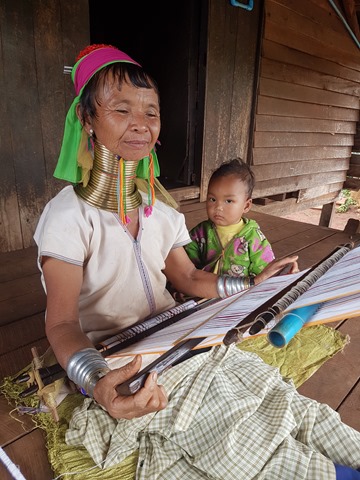 The Kayan are members of Kayin Ni (Red Kayin) race, descended from the Tibeto-Burman family of peoples. There are four main Kayan groups; the Kayan Lahta, the Kayan Ka Ngan, the Kayan Ka Kaung and the Kayan Lahwi. This last group is better known in Myanmar as Padaung (or Pattaung to the Shan people) meaning copper neck”.
The Kayan are members of Kayin Ni (Red Kayin) race, descended from the Tibeto-Burman family of peoples. There are four main Kayan groups; the Kayan Lahta, the Kayan Ka Ngan, the Kayan Ka Kaung and the Kayan Lahwi. This last group is better known in Myanmar as Padaung (or Pattaung to the Shan people) meaning copper neck”.
Among foreigners, the Padaung have also been called by a different, less pleasant name in the past: giraffe women. Over the years their habit of wearing coils on their ankles, their wrists and – most famously – their necks have been subject to much international curiosity, their exotic-looking appearance making them fascinating to ethnographers and snap-happy tourists alike.
At night the women take off the coils before they sleep. But some say the rings leave the neck muscles so weak that, once she wears them for a long period, a Padaung woman is unable to hold her head up without them. In other words, the rings are for life.
The coils give the appearance of lengthening the neck, but in fact they work the opposite way: Rather than stretching the chin upwards, they weigh the shoulder bones down. Up to 26 loops of brass can weigh around 6.8 kilograms (15 pounds) in all and wearing them from the age of five or six and adding new rings until the body has finished growing in the late teens, distorts the natural skeletal structure of the collarbones over time.
At night the women take off the coils before they sleep. But some say the rings leave the neck muscles so weak that once she wears them for a long period, a Padaung is unable to hold her head up without them. In other words, the rings are for life.
Many Padaung live just over the Thai-Myanmar border, and they are permitted by thai authorities to remain there as living tourist attractions. Tourism businesses hire the padaung women, paying them a monthly income to wear the coils and then charging tourists to come and see them and take photos – and hopefully also buy some of their intricate handiwork. It is a complicated arrangement – it provides enough income to give education and a hope of a better future for children displaced by war, but others criticize the arrangement, equating it to a kind of zoo for ethnic people. There is no right or wrong answer to these questions – as with travelling anywhere, it is up to each traveler to decide how best to contribute to the local economy, and how to learn about local practices sensitively and respectfully.
In Myanmar, the Kayan people – including the Padaung – can also be found in popular tourist site began and
 Inle lake, as well as in Shan State, so you may be able to meet them and learn about their history without having to visit Thailand. But since their traditional homeland is Kayah State, Capital Loikaw, why not take a trip to see where these traditions begin?
Inle lake, as well as in Shan State, so you may be able to meet them and learn about their history without having to visit Thailand. But since their traditional homeland is Kayah State, Capital Loikaw, why not take a trip to see where these traditions begin?
You can travel overland from Mandalay or Nay Pyi Taw through Shan State along the Pin Laung-Loikaw road. You can also take the Taung-Demawso road, passes through Taungoo township in Bago Region but that means crawling along narrow winding hill passes at 15 kilometers an hour. Unless you are a fan of steep slopes and sharp curves, it is recommended to seek another route.
Why not fly from Yangon to Loikaw airport?
As you’ll see when you arrive, the city itself is reasonably small, at around 20,000 people. But for a city of this size you won’t have any trouble finding accommodation. Restaurants, hotels and guest-houses are plenty, offering convenience for local and international visitors.
Getting around is an easy as hiring a car and driver, a motorbike or a trishaw – a sort of bicycle with sidecar. Don’t miss the colorful marker and be sure to drop in display of traditional artifacts and handicrafts made by people in the area.
There is also plenty to see in a day tip from Loikaw. About 20 kilometers away is Lawpita Falls, which powers the country’s main hydropower station, producing a quarter of the country’s hydroelectricity.
Taung Kwe Zedi Pagoda, another landmark of Kayah State, sits on a twin-peaked mountain and allows stirring views of the city. The city is nestled in mountainous countryside, with each stream and hill seeming to be connected to myth and legend.
South of Loikaw township, past Demawso township, are three famous mountains named Golden mountain, Silver mountain and Ruby mountain. They are made famous by the romantic story Dwe Me Naw, about Kinnari and Kinnara, mythical birds with human heads and torsos. The mountains are visible from Ngwe Taung Dam and the shrines for the seven sisters of Dwe Me Naw are also nearby, some of different styles than usually seen for nats, or spirits in Myanmar.
Hti Pwint Lake (or “spreading umbrella” lake), located in the compound of the shrine, is fascinating, as you can sometimes see mud in the lake bubbling up like blooming lotus flowers then fading away.
If you’d like to visit some Padaung villages, try San Boon. Han Thaw Khu or Pan Pet villages. You’ll find more than just coils – the Padaung people have a rich melting pot of traditions unlike anywhere else in the world.
For instance, you may be surprised to discover that the area has a strong Christian tradition. In the early 19th century, Italian Catholic missions arrived in the area. Most of the more than 300 Kayan villages are Roman Catholic to this day – there are only 40 Buddhist Kayan villages – and in some you can see the remains of old churches built by the original converts.
Not many other Catholics in the world, however, probably celebrate Kay Htein Boe, the most famous Kayan festival. For three days at the end of March or the start of April, the residents cut down a long straight tree from the forest, strip off all the branches and carry it into the village so that everyone can gather around it to dance and worship. They pray for better crops in the coming season, using a palm-leaf book and a chicken bone to predict the results.
Kay Htein Boe is but one of many Kayan celebrations, which include New Year festival, Christmas, Kayan National Day and Kayah State Day. All are celebrated boisterously, with unique dancing styles and traditional songs which are always sung loudly and with great happiness.
 Among Kayan villages near Loikaw, Pan Pet village attracts the most visitors. Located more than 1200 metres (4000 feet) above sea level, Pan Pet stands in a different world, providing a fascinating glimpse into the traditional culture and livelihoods of the area.
Among Kayan villages near Loikaw, Pan Pet village attracts the most visitors. Located more than 1200 metres (4000 feet) above sea level, Pan Pet stands in a different world, providing a fascinating glimpse into the traditional culture and livelihoods of the area.
Most of the houses are raised on stilts, meaning the floors are elevated off the ground nearly the height of a person. Residents make their living by cultivating, logging and gardening. Farmers grow corn, paddy, soya-bean and pigeon pea, and also breed cattle, pigs and poultry. To supplement their diet, they hunt the creatures of the forest, including barking deer, sambur, rabbit and wildcat.
If you join them for a meal, you’ll probably be offered khaung yay (local wine), a treat given to guests and made from rice to corn. Try it if you like but go easy: it is an intoxicating brew!
Today many Padaung wonder about how long the neck-coil tradition will last. As cultures become less isolated, the Kayan are facing a crossroads, and it will be up to the next generation of young women to decide whether their daughters will take up the coils or not.
But as a trip to Loikaw will prove, there is much more to these people than simply their rings. You won’t see them as giraffe women once you’ve met them: Instead, you’ll remember the skill of their weaving, the sound of their rice being pounded, and most of all the beautiful hospitality they offer in their homes which those driven away miss so much.
Source: Mann Yadanarpon Airlines
Author: Zin Min Swe
Read more:
Loikaw and Kayah State Travel Guide
Loikaw and Kayah Tour

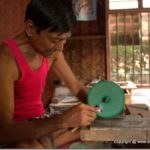
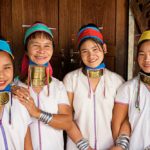

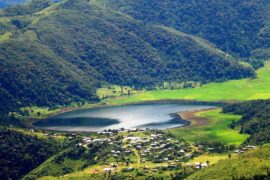
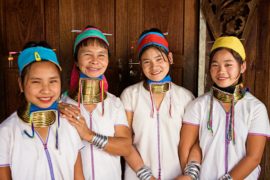
Comments are closed.